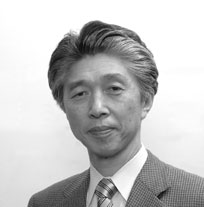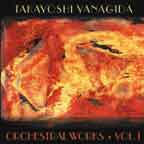Takayoshi Yanagida
 photo: Koji Shitsukawa
photo: Koji Shitsukawa
Born March 27, 1948 in Sapporo City, Hokkaido, Takayoshi Yanagida
was fond of music early on, studying piano from the age of 8. He was drawn particularly
to the music of Béla Bartok and Igor Stravinsky, and began composing within a few
years. At Musashino Academia Musicae he studied composition under Klaus Pringsheim and
at age 21 received the 1st prize in the Composition Division of the
NHK/Mainichi Shinbun
Music Competition of Japan. He also became the first composer to receive a rare award
given to a particularly excellent composition in the same competition. Graduate studies
took him to Harald Genzmer at the Munich Hochschule für Musik. During this period
his association with Munich's eclectic
Musik Unser Zeit and composer Wolfgang Fortner
led to work in pantomime and ultimately Yanagida's self- choreographed public performances
there.
Upon returning to Japan, he became a member of the
Japan Society for
Contemporary Music, The
Japan Federation of Composers and the
International
Society of Composers of Music, and has since enjoyed numerous premiers at their sponsored
recitals and many published scores. Yanagida's long involvement in educational
programming at the Japan Broadcasting Corporation (NHK) has resulted in scores for a
number of videos and motion pictures. In 1993 he joined a group of colleagues in
establishing the
Orchestra Project, resulting in performances of many of his recent
scores and an Award of Excellence at the
National Art Festival sponsored by the
Japanese Government's Agency for Cultural Affairs. Presently, Takayoshi Yanagida
is professor of music at Bunkyo University where he teaches composition and music
theory.
"Tour de force collection - Yanagida is one of the few Japanese composers brave
enough to write in the lyrical, post-serial, romantic style pioneered by Toru Takemistu -
expounds in striking clarity its intrinsic poetry".
--
Jack Gabel, NPM

|
STREAMING AUDIO SAMPLES
If not installed, download free player (links below).
Then set browser preferences to player of choice.
|
|
No fat downloads
streams only
|



 mp3 (32kbps) audio
(streaming excerpts)
|
[ 1 ] Libretto on a Dreamy Vision
(solo flute & orchestra) |
LISTEN |
| |
|
Memory of Time (orchestra) |
|
| [ 2 ] (Excerpt 1) |
LISTEN |
| [ 3 ] (Excerpt 2) |
LISTEN |
| [ 4 ] (Excerpt 3) |
LISTEN
|
| |
| [ 5 ] A Poetic Grace (solo 20 string koto & orchestra) |
LISTEN
|
| |
Elms bathed in sunshine...
(solo piano & orchestra) |
|
| [ 6 ] (movt. 1) |
LISTEN |
| [ 7 ] (movt. 2) |
LISTEN |
| [ 8 ] (movt. 3) |
LISTEN
|
| |
Program Notes
Libretto on a Dreamy Vision (1993) - [17:00]
Solo Flute: Hiroaki Masunaga
The Tokyo Symphony Orchestra
Conductor: Kazuhiko Komatsu
Memory of Time (1999) - [19:23]
The Tokyo Symphony Orchestra
Conductor Laureate: Kazuyoshi Akiyama
A Poetic Grace (2000) - [18:03]
Solo 20-string Koto: Noriko Sanagi
The Sapporo Symphony Orchestra
Conductor: Kazuhiko Komatsu
Elms bathed in sunshine... (2001) - [18:32]
Solo Piano: Yukine Uehara
The Tokyo Symphony Orchestra
Conductor Laureate: Kazuyoshi Akiyama
Libretto on a Dreamy Vision for Flute and Orchestra was written
and premiered in 1993 through the
Orchestra Project by flutist Hiroaki Masunaga
and Kazuhiko Komatsu, conductor. Flute is Yanagida's favorite instrument and
clearly dominates his catalogue. Prior to
Libretto...,
Aubade for Flute
and String Orchestra was his best known flute score. Following no specific
program,
Libretto... envisions the unrolling of a pictorial scroll,
reflecting mutations of an intrinsically Japanese melodic tenor, unfolding over
time, within the flux of orchestral sonorities.
Memory of Time for Orchestra was also written for the
Orchestra
Project and premiered in its 1999 concert by The Tokyo Symphony Orchestra under
Kazuyoshi Akiyama. It received the
Award of Excellence during the National Art Festival,
sponsored by the Japanese Government's Agency for Cultural Affairs. The work is for
flute, oboe, and clarinet soloists, positioned at the center of the orchestra, not
unlike a European Baroque concertino. As for the work's development from its central
theme, Yanagida writes, "I wanted to adopt into my musical work an aesthetic more akin
to poetic structure and sensitivity, in particular of
tanka, and
haiku
- poetic forms both deeply reflective of Japanese artistic sentiments." First the
three soloists play the theme, which is then transfigured through the orchestra, as
each solo instrument joins the ensemble and their aggregate 'song' flows through
time into the depths of memory.
A Poetic Grace for 20-string Koto and Orchestra
was commissioned by Noriko Sanagi, of Sapporo, who premiered it in 2000 with the
Sapporo Symphony Orchestra, conducted by Kazuhiko Komatsu, on a special concert:
Twentieth Century Japanese Composers. In the composer's words, "I've envisioned,
rather than the usual Western-style concerto that may emphasize contrast and tonal
individuality, an imaginary pure realm called rikugo, hidden mysteriously within
the known cosmos - a concept of ancient Chinese origin. A solo instrument, bearing the
'song,' emerges from the encompassing sonority. Again we are asked to contemplate
the literary aspect: what may be the orchestral music that emanates from the tradition
of Japanese prosody?"
Elms bathed in sunshine...for Piano and Orchestra
was written and premiered at the 2001
Orchestra Project Concert by pianist
Yukine Uehara and The Tokyo Symphony Orchestra, conducted by Kazuyoshi Akiyama.
Representing a 'poem', the work consists of three movements where the circulating
themes transfigure within each movement. The work presages an aesthetic turn toward
structure and style more Western than in any of Yanagida's previous publications.
In 2004, three years after writing
Elms..., the composer published his
Piano Concerto No. 2,
Transfiguration of Dreams, which revealed a shift in musical perspective from essentially
Asian to a more Western display of a heightened sense of freedom. In the title the
'Elms'
are in Sapporo, Hokkaido Prefecture, where the composer was born. The title recollects
where he passed in his youth, meditating on music while bathed in the sunlight spilling
off the leaves of those elms.







